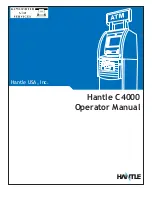
12
PROGRAMMING MODE ENTRY (PAR KEY)
The meter normally operates in the Display Mode. No parameters can be
programmed in this mode. The Programming Mode is entered by pressing the
PAR
key. If it is not accessible then it is locked by either a security code, or a
hardware lock.
Two types of programming modes are available. Quick Programming Mode
permits only certain parameters to be viewed and/or modified. All meter
functions continue to operate except the front panel keys change to
Programming Mode Operations. Quick Programming Mode is configured in
Module 3. Full Programming Mode permits all parameters to be viewed and
modified. In this mode, incoming counts may not be recognized correctly, the
front panel keys change to Programming Mode Operations and certain user
input functions are disabled. Throughout this document, Programming Mode
(without Quick in front) always refers to “Full” Programming.
MODULE ENTRY (ARROW & PAR KEYS)
The Programming Menu is organized into nine modules. These modules group
together parameters that are related in function. The display will alternate between
&!(
and the present module. The arrow keys (
F1
!
and
F2
"
) are used to select
the desired module. The displayed module is entered by pressing the
PAR
key.
MODULE MENU (PAR KEY)
Each module has a separate module menu (which is shown at the start of each
module discussion). The
PAR
key is pressed to advance to a particular parameter
to be changed, without changing the programming of preceding parameters.
After completing a module, the display will return to
&!( *+
. Programming may
continue by accessing additional modules.
SELECTION / VALUE ENTRY (ARROW & PAR KEYS)
For each parameter, the display alternates between the present parameter and
the selections/value for that parameter. The arrow keys (
F1
!
and
F2
"
) are used
to move through the selections/values for that parameter. Pressing the
PAR
key,
stores and activates the displayed selection/value. This also advances the meter
to the next parameter.
For numeric values, the
RST
key may be used to select a specific digit to be
changed. Once a digit is selected, the arrow keys are used to increment or
decrement that digit to the desired number.
PROGRAMMING MODE EXIT (DSP KEY or at
&!( *+
PAR KEY)
The Programming Mode is exited by pressing the
DSP
key (from anywhere
in the Programming Mode) or the
PAR
key (with
&!( *+
displayed). This will
commit any stored parameter changes to memory and return the meter to the
Display Mode. If a parameter was just changed, the
PAR
key should be pressed
to store the change before pressing the
DSP
key. (If power loss occurs before
returning to the Display Mode, verify recent parameter changes.)
PROGRAMMING TIPS
It is recommended to start with Module 1 for counting and Module 4 for rate.
If lost or confused while programming, press the
DSP
key and start over. When
programming is complete, it is recommended to record the parameter
programming on the Parameter User Chart and lock out parameter
programming with a user input or lock-out code.
FACTORY SETTINGS
Factory Settings may be completely restored in Module 9. This is a good
starting point for programming problems. Most parameters can be left at their
Factory Settings without affecting basic start-up. These parameters are
identified throughout the module explanations.
ALTERNATING SELECTION DISPLAY
In the explanation of the modules, the following dual display with arrows will
appear. This is used to illustrate the display alternating between the parameter
on top and the parameter’s Factory Setting on the bottom. In most cases,
selections and values for the parameter will be listed on the right.
6.0 P
ROGRAMMING THE
M
ETER
OVERVIEW
PROGRAMMING MENU
Indicates Program Mode Alternating Display
Factory Settings are shown.
!
"
,-'
. /*'
Parameter
Selection/Value
Module 1 is the programming for Counter A, Counter B and the Prescaler Output. Counter B parameters follow the Prescaler parameters. For
maximum input frequency, the counters should be set to mode NONE and the Prescaler to NO when they are not in use. When set to NONE
or NO, the remaining related parameters are not accessible. A corresponding annunciator indicates the counter being shown in the Display
Mode. An Exchange Parameter Lists feature for scale factors and count load values is explained in Module 2.
PARAMETER MENU
x = Counter A or Counter B
6.1 MODULE 1 - C
OUNT
A & B I
NPUT
P
ARAMETERS
(
/0(),
)
Shaded areas represent program access that is model dependent.
PAXC & I
Содержание CUB 1
Страница 30: ...7 This page intentionally left blank...
Страница 46: ...5...
Страница 47: ...6...
Страница 48: ...7...
















































